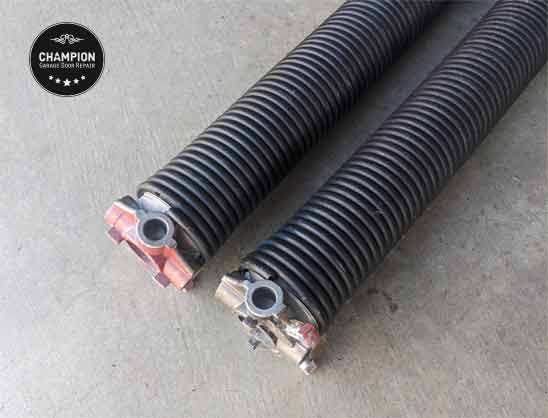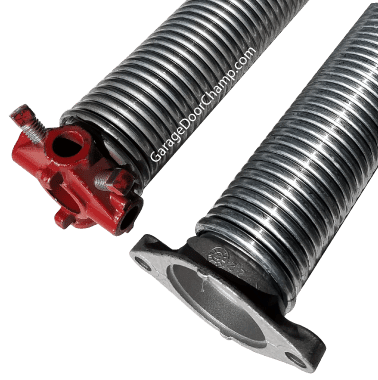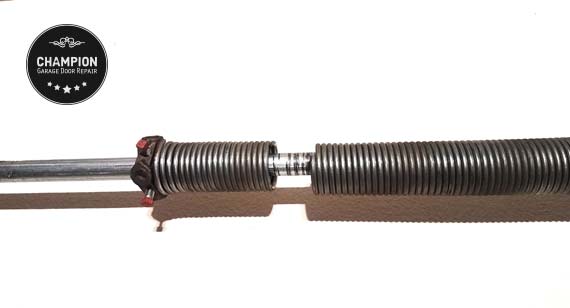Torsion springs play a crucial role in providing the necessary counterbalance for raising and lowering garage doors. A fundamental understanding of these springs is essential for maintaining the safety and functionality of the garage door.
What Are Garage Door Torsion Springs?
Torsion springs are elastic steel coils specifically designed to support the weight of a garage door by generating torque along the pivot point. With the capacity to handle weights exceeding 800 lbs., these springs store the energy necessary to counterbalance the door’s weight, enabling controlled and smooth movement.
Table of Contents
- Torsion Springs: Sizing and Placement
- Key Dimensions for Torsion Springs
- The Right Spring for Your Garage Door
- Can You Install a Stronger Spring?
- Why Garage Door Springs Break
- Factors That Influence the Longevity of Springs
- Oil Tempered Springs vs Galvanized Springs
- Symptoms of Faulty or Broken Torsion Springs
- What to Do If You Have a Broken Torsion Spring
- Single Torsion Spring vs Two Springs
How Torsion Springs Work
When the garage door is closed, the springs are in their maximum loaded state. As the garage door opens, this tension is gradually released until the springs return to their equilibrium state.
The reason the springs are at their maximum loaded state when the garage door is closed is to ensure that the force needed to support the door’s weight roughly matches it. As the garage door opens, the door sections begin to lay horizontally on the horizontal tracks, reducing the weight that needs to be supported.
Understanding Torsion Springs: Sizing and Placement
The springs are not one-size-fits-all; they come in various sizes to match the specific requirements of different garage doors and the settings of the garage. For example, a garage door constructed with low gauge steel will require a spring that generates a higher torque output compared to a garage door constructed with higher gauge steel.
Torsion springs are typically positioned horizontally above the garage door. However, in the case of rear torsion assemblies, the springs are located behind the door. A torsion spring is securely mounted to the spring anchor bracket (or center bracket) using its stationary cone and to the axle (torsion tube) through its winding cone.
Key Dimensions for Torsion Springs
Accurate measurement of a torsion spring involves taking into account the following dimensions:
- Coil Body Length: This measurement includes the entire length of the spring’s coil body, excluding the cones. It is a fundamental dimension that impacts the spring’s performance and strength.
- Inside Diameter (I.D.): The inside diameter refers to the inner measurement of the spring’s coil.
- Wire Diameter: The thickness of the wire used to create the spring’s coils, which affects the spring’s strength.
Measure the dimensions of a torsion spring when it is in its equilibrium state, as a loaded spring adds travel distance to its coil and might cause an irregular inside diameter.
What Is the Right Spring for Your Garage Door?
Choosing a torsion spring for an overhead garage door requires a careful analysis of the door’s specifications on a case-by-case basis. However, here are the most common spring types used in typical garage doors:
- 16×7 uninsulated metal garage doors: (2) springs, each measuring 207 x 1 3/4″ x 27”
- 8×7 uninsulated metal garage doors: (1) spring, measuring 207 x 1 3/4″ x 27”
- 16×7 insulated poly-back metal garage doors: (2) springs, each measuring 225 x 1 3/4″ x 28”
- 8×7 insulated poly-back metal garage doors: (1) spring, measuring 225 x 1 3/4″ x 28”
- 16×7 insulated steel-back metal garage doors: (2) springs, each measuring 234 x 1 3/4″ x 30”
- 8×7 insulated steel-back metal garage doors: (1) spring, measuring 234 x 1 3/4″ x 30”
- 16×7 wood uninsulated garage doors: (2) springs, each measuring 250 x 1 3/4″ x 33”
- 8×7 wood uninsulated garage doors: (1) spring, measuring 250 x 1 3/4″ x 33”
- Custom wood garage doors: Case-by-case basis.
- Full-view aluminum garage doors: Case-by-case basis.
The best spring for any garage door is one that properly balances and supports the door’s weight. Several factors can affect the door’s weight, which, in turn, influences the required spring size.
For example, an insulated steel-back garage door with a higher R-Value will be heavier than a steel-back garage door with a lower R-Value, and therefore, it may require stronger torsion springs, such as 243 x 1 3/4″ x 33”, rather than the aforementioned 234 x 1 3/4″ x 30” springs.
Due to the complexity and the number of factors involved, it is always best to adhere to the manufacturer’s specifications or consult a licensed garage door repair company when choosing springs for your garage door.
Can You Install a Stronger Spring on Your Garage Door?
You can replace your spring with one that has different properties as long as it’s designed to support the same weight and has a similar torque output. However, there are two main reasons why you cannot simply replace the proper spring with a stronger one, or vice versa:
Balance Problems
Stronger springs, designed to support heavier doors, will generate excessive force, making it difficult to close the garage door properly. On the other hand, weaker springs, designed for lighter doors, won’t provide enough force, resulting in a heavy garage door.
An imbalanced garage door that either pulls up or becomes too heavy poses risks such as coming off its tracks and causing wear and tear on garage door mechanisms, including rollers, hinges, and the electric opener.
Cables Problems
The door cables must always be under tension, and a compatible spring can be precisely calibrated to ensure proper cable tension. However, if the spring is incompatible, it may not be accurately calibrated and might fail to generate the required force to maintain proper cable tension. This condition can lead to the cables coming off the drum’s groove, potentially causing the garage door to come off its tracks.
Why Garage Door Springs Break?
Springs commonly break as a result of regular wear and tear, where they endure stress beyond their elastic limit, ultimately resulting in failure.
Spring Breakage and Hooke’s Law
In the 17th century, the English scientist Robert Hooke published a fundamental principle of physics known as Hooke’s Law, which states that the strain in an object is proportional to the stress applied to it within its elastic limit (Fs = kx).
As the Extension, So the Force – Robert Hooke
While Hooke’s Law is a reasonably accurate approximation for most solid objects, it is primarily applicable to small forces and deformations. Solid objects, including torsion springs, cannot be twisted beyond their sustainable elastic limit without undergoing a change of state or deformation.
When a loaded torsion spring exceeds its elastic limit, it undergoes plastic deformation, resulting in a permanent, non-reversible change to the spring’s wire. Over time, this process can lead to cracks, fractures, and ultimately, spring breakage.
What Factors Influence the Longevity of Springs?
In addition to regular wear and tear, several factors can accelerate the wear and reduce the lifespan of springs. One significant factor is friction. Over time, the garage door center bearing and end bearings can stiffen and become prone to sticking. Furthermore, misalignment, corrosion, worn rollers, bent tracks and bent door sections can all contribute to increased friction, making it more challenging for the torsion tube and springs to operate smoothly.
These conditions, along with common problems, can reduce the lifespan of the springs, potentially leading to unexpected breakdowns or the garage door coming off its tracks. The garage door’s mechanisms maintain equilibrium with each other, and keeping them in proper order is essential to ensure maximum lifespan, system durability, and reliability.
Estimating Torsion Spring Lifespan
Torsion springs typically have a cycle life ranging from 5,000 to 30,000 cycles, with one full cycle comprising the complete opening and closing of a garage door.
With regular daily use, torsion springs can last anywhere from 2 to 20 years on average. You can calculate a torsion spring’s lifespan by dividing its cycle life by the average number of times it completes one full cycle, defined as the garage door fully opening and closing.
For example, if a garage door has a torsion spring rated for 15,000 cycles and it opens and closes approximately 3 times a day, the spring’s life expectancy would be 5,000 days, equivalent to 13 years and 7 months.
Oil-Tempered Springs vs. Galvanized Springs
Torsion springs are typically made from steel, and among the various types of garage door torsion springs, the most common are oil-tempered and galvanized springs.
Oil-Tempered Spring
The oil-tempered torsion spring is constructed using high-carbon steel wire. During the tempering process, the spring’s wire undergoes heat treatment before production. The primary aim of tempering is to enhance toughness by reducing the hardness of the spring’s wire.
This process eliminates general stress relieve, preserves the coil’s strength, and increases its ductility. Consequently, the spring’s coil retains its toughness and firmness, requiring no adjustment to its torque level over time.

The process of heat-treating steel has a long history dating back to the time when metalworkers forged strong and durable swords. Just as oil-tempered springs are both strong and flexible, a well-crafted sword needed to possess the same qualities to absorb shocks along its length without cracking or breaking.
Similar to how a reputable springs manufacturer creates quality springs today, a skilled swordsmith in the past knew the art of forging a quality sword by achieving the perfect balance between strength, flexibility, hardness, and weight distribution.
Galvanized Spring
Galvanized torsion springs are also made from high-carbon steel wire, but instead of heat treatment, the wire is coated with zinc. This process involves dipping the spring’s wire in molten zinc, resulting in corrosion resistance.

Unlike oil-tempered torsion springs, the galvanized springs’ resistance to corrosion makes them more durable and resilient to atmospheric changes in temperature and humidity. When steel is exposed to water, humidity, or salty corrosive air, it undergoes anode and cathode reactions, leading to oxidation, or rust. This rust weakens the steel, and for load-bearing objects, this process eventually leads to fracture.
Common Symptoms of Faulty or Broken Torsion Springs
These five common indicators can help you determine whether your torsion springs are worn out or broken.
Loose or Broken Door Cables
Loose or broken door cables are a common indication of a faulty torsion spring, especially when your garage door operates with a single torsion spring. A single spring supports the door’s weight and maintains tension on the pulley’s groove. When the spring becomes worn or breaks, the cables can start to wander in various directions without proper support.
Garage Door Won’t Open or Only Opens a Few Inches
You may notice that your garage door opens only a few inches before stopping, or it moves at an unusually slow pace, slower than its usual speed. These issues often indicate a faulty or broken spring.
Loud Bang in Your Garage
A loud bang in the garage is another indicator of a broken torsion spring. This sound can be quite loud, resembling a gunshot or a break-in. It occurs due to the rapid release of a significant amount of torque when the tension spring breaks suddenly.
2-Inch Spring Gap
An approximate 2-inch gap in your torsion spring’s coil, it’s a clear sign of breakage. When the spring is torqued, it extends to create this 2-inch travel distance. However, when it breaks, the force stored in the spring causes it to revert to its natural state, resulting in the fracture splitting the spring’s coil into two separate coils.

Bent Garage Door Top Section
A garage door with a noticeable bend at the top or upper section can be a clear and potentially costly indicator of a broken torsion spring. This issue arises when the garage door opener attempts to lift the door, but the door’s weight exceeds its capacity. Consequently, the garage door opener exerts force to lift the door, leading to a bend in the top section due to the excessive weight.
Jerky Garage Door
You may also notice that your garage door opens and closes in a jerky manner. While this could be a sign that the garage door needs lubrication or maintenance, it may also indicate a scenario where the torsion springs are broken, struggling to bear the load of the garage door.
If you suspect that a torsion spring on your garage door has broken, do not attempt to disengage the door from the opener while it is in the open position. Disengaging the door when it’s open carries the risk of the several-hundred-pound door crashing to the ground because it lacks support from the torsion springs.
Try to pull the manual release rope while the garage door is in the closed position. If you cannot open the door manually while it’s disconnected from the opener, it’s likely that the torsion springs are indeed broken. When the springs are functioning properly, the door should open relatively easily. If the torsion springs are broken, you can still open the door manually, but it will likely require the strength of multiple individuals to do so.
If you intend to leave the garage door in the open position, it is highly recommended to secure the door by blocking the door tracks with vice-grips on either side. Additionally, make sure to unplug the garage door opener unit to ensure the door remains securely in place.
What to Do If You Have a Faulty or Broken Torsion Spring
Given the inherent dangers associated with repairing broken springs, it is highly advisable to contact a licensed garage door company or a local garage door repair company near you that offers emergency repair services and can fix the spring on the same day.
When it comes to replacing broken springs yourself, the process involves numerous steps that must be followed accurately and poses several potential dangers. Torsion springs store significant amounts of torque, and mishandling them can lead to the sudden release of this torque, resulting in severe injuries or worse.
If you decide to do it yourself, be sure to take proper safety precautions and familiarize yourself with the process of repairing a garage door before starting the work.
Single Torsion Spring vs. Two Springs
Some garage door systems use multiple torsion springs, while others rely on a single spring. One of the advantages of a dual-spring system is that if one spring were to break, the other spring continues to bear some of the door’s weight, preventing it from abruptly crashing down. Learn more about the advantages to having more than one spring.
Should You Replace All Springs if One Broke?
In a multiple-spring system, if one spring breaks, it’s often advisable to replace all of your springs simultaneously. This is because when one spring breaks, it’s likely that the others may also fail within the next 6 months or even sooner.
How Can You Open a Garage Door with Broken Springs?
A single torsion assembly with a single broken spring or a duale spring system with two broken springs is bad news as this requires much more effort to open the door and you will need enough strong people to help you.
In case that there’s more than one spring, other springs that may still be functioning continue to support the door’s mass. This is usually enough to still lift a garage door by yourself. Keep in mind that some doors such as insulated, custom and wood garage doors can be extremely heavy and you most likely won’t be able to open them even when only one spring is broken.
To prevent damage to the door’s electric opener and sections, it’s advisable to disconnect the door from the motor by pulling the emergency release cord. Afterward, manually lift the door open. Once the door is in the open position, use vice-grips or a c-clamp to secure it in place on the garage door tracks.
How Long Does It Take to Repair a Broken Spring?
In most cases, experienced garage door repair technicians can complete the replacement within a timeframe of one to three hours. The exact duration may vary depending on factors such as the type of door and the complexity of the torsion assembly.
Generally, standard spring replacements are typically done within an hour, whereas custom garage doors with custom springs may require a longer timeframe for completion.
How to Maintain Garage Door Torsion Springs?
Maintaining the springs of your garage door is crucial to ensure its proper balance. It’s recommended to recalibrate the springs every 6 to 12 months, depending on usage frequency. Lubricating the springs is unnecessary unless you hear a popping sound coming from them.
Whether maintained by a professional or done by you, ensuring your garage door functions well is imperative for its safety, proper operation, and functional integrity.








You gave really good safety tips about what to do to make sure that you don’t get hurt if the garage door springs break. My garage door has been jerky when I open and close it and think that the springs might be close to breaking. I’ll have to call a garage door repair company out to look at my door and see if it is the springs or not.
Disconnecting the garage door when the spring may be broken could be a bad idea. Our garage door is stuck ajar and my husband thinks it’s best to try and fix it when he gets home, which I think is a bad idea. I’ll opt to call a garage door repair service to have ours looked at and serviced. That way I can hopefully get my car out of the garage by tomorrow so that I won’t have to call a cab to work again.
I’ve been thinking about getting a garage door torsion spring repair service soon because I’ve been troubleshooting mine for some time now. I think it’s safe to assume that it’s faulty springs that make my garage door slam shut instead of slowly closing.
Damaged garage door spring can affect your door’s efficiency
Can a torsion spring be moved from the front of door to rear because of clearance issues
Hello Samuel. Yes, the torsion assembly can be installed at the back end of the garage (end of the garage door’s horizontal tracks).
hey friends.
I want to replace a double torsion spring for a garage door, bellow the information,
what kind of torsion spring should I need to buy?
thanks for your assistance really appreciate. Fabian
Brand Door : Wayne Dalton
Year: (approx. 2000)
Made from Steal, and 2 torsion spring.
Door Heights: 11ft
Door size: 122 inches Wide
Section QTY: 6 ( 24’’x24’’x24’’x21’’x21’’x21’’)
Weight: 290 pounds
Former Length torsion spring: 44’’ ½
Wire size: 2’’ 1/2 : (for 10 coil count) :
Inside spring size :2’’ diameter
Hello Fabian, you should always replace the garage door spring with the OEM spring that came with the door unless you have the knowledge to convert it to a spring that produces the same torque output. If you’d like us to do that for you please provide us with:
1. The spring’s length when it’s in equilibrium state.
2. The spring’s coil inner diameter.
3. The spring’s gauge.
I have a technical question for you. I purchased a standard 8 ft Garage door and cut 2 ft off of each panel to make it fit a 6 ft opening in a shed. The door is installed and when I tension the spring it is either too much tension and the door springs up and wont stay shut or when there’s not enough tension it unspools the cable off the drum when the doors is raised. Im thinking if I shorten the spring I can solve the problem. Or does it just need some real fine tuning. Any ideas?
Hello Kevin, shortening the spring will cause it to generate a greater torque output. You took off weight from your garage door by removing part of the sections, therefore, you’ll need to replace the spring with a spring that support a lighter door (if fine tuning them doesn’t help). If you can provide us with the door’s weight, size, and track’s radius, we’ll be able to tell you what spring you need.
Good Morning: We had our double torsion springs replaced on Monday. On Friday morning when opening the electronic door, the bracket arm of the opener completely separated from the door, bolts and all. Might we have set the spring too tight, or not enough? The fact this happened within a couple days of replacing the springs makes me think it is the setting of the spring.
Hello L Patterson, it’s possible that the setting of the spring causing the issue. You’d want to test the garage door balance first. If the door is too heavy or pulling up, you’d want to have that fixed. Note that a minor deviation shouldn’t be a concern.
Good afternoon,
I’m fixing to add insulation to my garage door and it will make it heavier can i tune the existing springs for that extra weight or should i replace the springs.
Tom
Hello Tom,
First, you can attempt to recalibrate the existing springs to properly support the door’s weight. If the door remains unbalanced after this adjustment, it’s advisable to replace the springs. Learn how to check the garage door balance here.
We are in a rural area and unable to get an installer. I am handy and can install but cannot find a resource to tell me what spring to order (what colour for weight) . My door Iweighs 220 pounds is a wooden door, and size 10 * 10, i was unable to find a 10*10 door regionally so i combined two 10*7 doors, shortening one to make the 10 ft height. Can you tell me how to determine the correct spring size to order? Thanks in advance!
Hello Willie, to determine the required springs, we’ll also need information about the track radius and the drums being used.